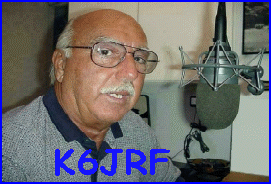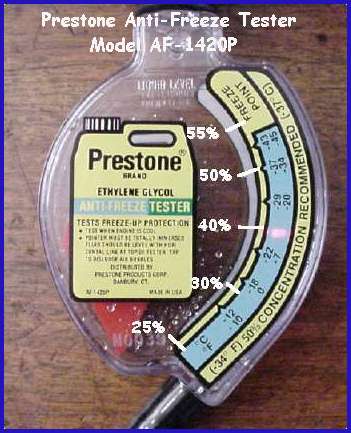
|
K6JRF's Page formerly W6FZC My Mercedes Benz S500 Coupe |

|
Analyze and Troubleshoot "Check Engine" MIL and Electronic Control Units (ECU)!
|
Lower Engine Operating Temperature w/ Coolant Additives
Common Problems
Description There are a few ways to lower the operating temperature of your Mercedes engine by the use of at least two coolant additives that can lower the engine temperature resulting in a more efficiently operating car. One is Water Wetter (WW), the other is Purple Ice (PI). Use of both products is explored here. Technical Information I am a bit put off by the 'oil-like' substance produced by WW, so I switched to a product made by called Purple Ice made by Calumet Branded Products in Texas. It is designed to provide improved metal wetting and excellent corrosion inhibition when added to distilled water with or without a glycol coolant. The most poorly maintained system in an automobile is usually the cooling system. Both WW and PI are wetting agents for engine cooling systems that reduce coolant temperatures by as much as 30°F. Both liquid products can be used to provide rust and corrosion protection in plain water for conventional cars or racing engines, which provide much better heat transfer properties than glycol-based antifreeze. Or they can be added to new or used antifreeze to improve the heat transfer of ethylene and propylene glycol systems. Both are designed for modern aluminum, cast iron, copper, brass, and bronze systems. Both products will help lower the operating engine temperature whether you use plain water or a water/glycol mixture. Consult the links above for more detail on each product. Directions for Use One 12 ounce bottle of WW treats 12 quarts of water or a 50% ethylene or propylene glycol solution. Similarly, one 16 ounce bottle of PI treats up to 16 quarts of 50% af/water solution. Add either product directly through the cooling system fill cap into the radiator or into the overflow tank. For best protection for aluminum, replenish or replace every 15,000 miles. The anti-scaling ingredients in WW or PI allows their use with ordinary tap water. However, using with distilled or deionized water will accomplish some scale removal in the cylinder head area. For maximum temperature reductions use the most water and the least antifreeze possible to prevent freezing in your climate. Even in summertime the use of air-conditioning can blow freezing air through the heater and cause freezing of the heater core unless at least 20% antifreeze is used. WW is sold in 12 ounce containers while PI is sold in 16 ounce bottles. This table shows the amount of anti-freeze needed to attain various mixture percentages in my S500 car with a 16.5 liter radiator capacity. For example, to attain a 40/60 mixture, add 7.0 quarts of AF and fill the remaining part with distilled water. Of course, add 1-1/3 bottles of WW or 1 bottle of PI.
 The antifreeze/water mixture in my car was not even close to what I thought it was! The car's AF was changed at the dealer
just before I bought it and I assumed (there's that word again!) it was 50/50% to start with. Bad assumption!
The antifreeze/water mixture in my car was not even close to what I thought it was! The car's AF was changed at the dealer
just before I bought it and I assumed (there's that word again!) it was 50/50% to start with. Bad assumption! So in doing my calculations to get to 30/70 or 20/80 starting from 50/50, I removed what I thought was enough coolant. But enough to err on the conservative side. Remember this 'experiment' is to see how better it cools with Water Wetter (WW) or Purple Ice (PI), so getting 'close' to the desired mixture is ok. The Prestone AF tester [AF-1420] can be bought at most automotive stores as well as Walmart and here. Testing my AF mixture, it was very close to 40/60% not 30/70%! So it MUST have been around 70/30% to start with! My point here is that it's hard to really know unless you test it YOURSELF! I've marked the concentration points on the picture so it's very easy to read your car's mixture ratio based on temperature in degrees C. The RED pointer indicates the freezing point protection. Do this with a cool (cold) radiator and fill the tester to the indicated mark. The Prestone PN is AF1420P. $2.89 at AutoZone and most popular auto stores. All this started because I want a year round mixture ratio that does not need to be changed. In San Diego, the temperature averages 71 F. The coldest it gets is possibly 36 F. We go into the mountains in the winter and it gets to no colder than -5F (-20C). So that where I'd like to set the car's mixture ratio. That works out to 35/65 ratio min! That should give adequate protection. I wonder how much cooler it would be with 20/80% and WW or PI? Probably never know. So even for me in SD, my original idea of 20/80% is impractical and a 35/65% ratio would be probably the absolute minimum acceptable ratio. If I were to always drive in SD only, then it probably would be ok. But for the colder northern climates it's a disaster waiting to happen. Even a 40/60% mixture could be very problematic for northern climates. Alternate Method  I am a bit put off by the 'oil-like' substance produced by WW, so I switched to a product called
Purple Ice made by Royal Purple.
It's purple in color, thus its name. It seems to be equal to WW and it does NOT leave a 'oil' film as does WW. It does reduce
the engine temperature so, it is my current choice. I use the same af/water ratio of 35/65 with Mercedes antifreeze and distilled
water. It works extremely well here in south-west climates.
I am a bit put off by the 'oil-like' substance produced by WW, so I switched to a product called
Purple Ice made by Royal Purple.
It's purple in color, thus its name. It seems to be equal to WW and it does NOT leave a 'oil' film as does WW. It does reduce
the engine temperature so, it is my current choice. I use the same af/water ratio of 35/65 with Mercedes antifreeze and distilled
water. It works extremely well here in south-west climates.It's a highly effective radiator coolant additive that can lower operating temperatures by up to 30° (F). It also prevents the formation of scale deposits in the radiator —ensuring optimum flow— and lubricates the seals of the water pump. PI works well in water or antifreeze/water mixtures and can be used in a wide variety of applications, including race cars all the way to heavy-duty trucks. As with WW, the key to PI’s effectiveness is a reduction in the surface tension of the coolant, which improves heat transfer through the cooling system and reduces coolant temperatures. It passes the ASTM D-2750 Corrosion Test and is formulated with Molybdate, an exclusive ingredient that coats all metal parts, providing superior rust, corrosion and erosion resistance. So since I live in a warm climate, a mixture ratio of 35/65% can be used. The cooling power is excellent and keeps the car's engine as cool as possible. Of course, remember that you do not have much freeze up protection since it only about +5F. This would be ok for summer driving in most areas of the USA but not recommended for fall or winter driving. If you live in a northern climate and want to take advantage of the Alternate Method, do the following. Just before Fall, pump out the overflow tank. This is about 1 gallon. Then refill with just Mercedes AF full strength. This will raise your mixture ratio to apx 50/50% if you started with 35/65% ratio. For other starting ratios, less Mercedes AF will be needed.
So carefully check your mixture percentage if you experience high temperature operation. You will probably find that the mixture ratio is greater than 50/50%. MB advises that in no case should the ratio be greater than 50/50%! For summer driving, the ratio can be lowered by use of AF and distilled water with or without WW or PI. However, PI seems to have the current edge in cooling capability and leaves no 'oil-film' residure. Use of either product does result in cooler engine operating temperatures. |
|
Send me |